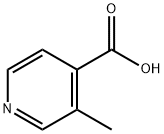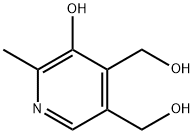4-Pyridoxic acid
Synonym(s):2-Methyl-3-hydroxy-4-carboxy-5-hydroxymethylpyridine;3-Hydroxy-5-(hydroxymethyl)-2-methyl-4-pyridinecarboxylic acid
- CAS NO.:82-82-6
- Empirical Formula: C8H9NO4
- Molecular Weight: 183.16
- MDL number: MFCD00006334
- EINECS: 201-440-8
- SAFETY DATA SHEET (SDS)
- Update Date: 2024-08-13 17:19:14

What is 4-Pyridoxic acid?
The Uses of 4-Pyridoxic acid
4-Pyridoxic Acid, a catabolite of vitamin B6 (P991735), is a water-soluble B-group vitamin that can be used as a urinary diagnostic biomarker for determining the nutritional status of these vitamins.
What are the applications of Application
4-Pyridoxic acid is a catabolite of vitamin B6
Definition
ChEBI: 4-pyridoxic acid is a methylpyridine that is 2-methylpyridine substituted by a hydroxy group at C-3, a carboxy group at C-4, and a hydroxymethyl group at C-5. It is the catabolic product of vitamin B6 and is excreted in the urine. It has a role as a mouse metabolite and a human urinary metabolite. It is a member of methylpyridines, a hydroxymethylpyridine, a monohydroxypyridine and a vitamin B6. It is functionally related to an isonicotinic acid. It is a conjugate acid of a 4-pyridoxate.
Synthesis Reference(s)
Journal of Heterocyclic Chemistry, 4, p. 625, 1967 DOI: 10.1002/jhet.5570040427
Enzyme inhibitor
This oxidized derivative (FW = 171.15 g/mol) of pyridoxal is the chief catabolic product of pyridoxine, pyridoxal, and pyridoxamine degradation; it can be isolated from human urine. The carboxyl group has a pKa value of 5.50 while the phenolic OH has a value of 9.75. 4-Pyridoxic acid has a blue fluorescence which is maximal between pH 3 and 4. Heating 4-pyridoxic acid in 0.5 N acid will convert the metabolite to its lactone, which has an even stronger fluorescence. Target(s): dextransucrase; glucose dehydrogenase; pyridoxal dehydrogenase; and pyridoxaminephosphate oxidase.
Properties of 4-Pyridoxic acid
| Melting point: | 258-261 °C (dec.) (lit.) |
| Boiling point: | 584.5±50.0 °C(Predicted) |
| Density | 1.480±0.06 g/cm3(Predicted) |
| storage temp. | -20°C |
| solubility | Aqueous Base (Slightly), Water (Very Slightly) |
| form | Solid |
| pka | 0.47±0.25(Predicted) |
| color | Pale Beige to Light Brown |
| Merck | 13,8071 |
| Stability: | Hygroscopic |
Safety information for 4-Pyridoxic acid
| Signal word | Warning |
| Pictogram(s) |
 Exclamation Mark Irritant GHS07 |
| GHS Hazard Statements |
H315:Skin corrosion/irritation H319:Serious eye damage/eye irritation H335:Specific target organ toxicity, single exposure;Respiratory tract irritation |
| Precautionary Statement Codes |
P261:Avoid breathing dust/fume/gas/mist/vapours/spray. P264:Wash hands thoroughly after handling. P264:Wash skin thouroughly after handling. P271:Use only outdoors or in a well-ventilated area. P280:Wear protective gloves/protective clothing/eye protection/face protection. P302+P352:IF ON SKIN: wash with plenty of soap and water. P305+P351+P338:IF IN EYES: Rinse cautiously with water for several minutes. Remove contact lenses, if present and easy to do. Continuerinsing. |
Computed Descriptors for 4-Pyridoxic acid
New Products
4-Fluorophenylacetic acid 4-Methylphenylacetic acid N-Boc-D-alaninol N-BOC-D/L-ALANINOL Tert-butyl bis(2-chloroethyl)carbamate 3-Morpholino-1-(4-nitrophenyl)-5,6-dihydropyridin- 2(1H)-one Furan-2,5-Dicarboxylic Acid Tropic acid S-2-CHLORO PROPIONIC ACID ETHYL ISOCYANOACETATE 2-Bromo-1,3-Bis(Dimethylamino)Trimethinium Hexafluorophosphate (6-METHYL-[1,3]DITHIOLO[4,5-b]QUINOXALIN-2-ONE INDAZOLE-3-CARBOXYLIC ACID 4-IODO BENZOIC ACID (2-Hydroxyphenyl)acetonitrile 4-Bromopyrazole 5,6-Dimethoxyindanone 2-(Cyanocyclohexyl)acetic acid 4-methoxy-3,5-dinitropyridine 2-aminopropyl benzoate hydrochloride 1-(4-(aminomethyl)benzyl)urea hydrochloride diethyl 2-(2-((tertbutoxycarbonyl)amino) ethyl)malonate tert-butyl 4- (ureidomethyl)benzylcarbamate Ethyl-2-chloro((4-methoxyphenyl)hydrazono)acetateRelated products of tetrahydrofuran








You may like
-
 4-Pyridoxic acid CAS 82-82-6View Details
4-Pyridoxic acid CAS 82-82-6View Details
82-82-6 -
 2033-24-1 98%View Details
2033-24-1 98%View Details
2033-24-1 -
 1975-50-4 98%View Details
1975-50-4 98%View Details
1975-50-4 -
 2-HYDROXY BENZYL ALCOHOL 98%View Details
2-HYDROXY BENZYL ALCOHOL 98%View Details
90-01-7 -
 2-Chloro-1,3-Bis(Dimethylamino)Trimethinium Hexafluorophosphate 221615-75-4 98%View Details
2-Chloro-1,3-Bis(Dimethylamino)Trimethinium Hexafluorophosphate 221615-75-4 98%View Details
221615-75-4 -
 61397-56-6 CIS BROMO BENZOATE 98%View Details
61397-56-6 CIS BROMO BENZOATE 98%View Details
61397-56-6 -
 14714-50-2 (2-Hydroxyphenyl)acetonitrile 98+View Details
14714-50-2 (2-Hydroxyphenyl)acetonitrile 98+View Details
14714-50-2 -
 118753-70-1 98+View Details
118753-70-1 98+View Details
118753-70-1